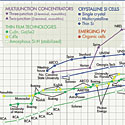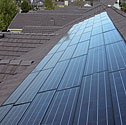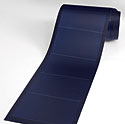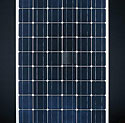Selling the Light of Day
Research drives the industry
Although solar research in European countries and Japan has contributed significantly to the development of those countries' photovoltaic markets-the largest in the world owing to widespread government incentives-the U.S. funds a number of research projects through the Department of Energy to push PV technology in new directions. The U.S.'s National Renewable Energy Laboratory (NREL) in Golden, Colorado, coordinates many research efforts, acting as a clearinghouse of information and approaches to the development of PV technology, either through partnerships or its own projects.
Photovoltaic technology consists of four different typologies, which together account for nine different varieties of PV cells either in production or development (refer to the NREL chart for the best research cell efficiencies). The most common are single crystal and multicrystalline silicon cells, which the NREL estimates to represent more than 90 percent of the market. These cells, combined into modules, function as additional components to buildings: awnings, canopies, or rooftop arrays. Multijunction concentrators simply stack up these cells; a laboratory cell developed by Spectrolab and the NREL achieved an efficiency of 34 percent in direct sunlight, by far among the highest efficiencies recorded outside of purely theoretical models. Efficiency is measured as a ratio of the cell's actual electrical energy output to the available sun energy incident on the device. Commercially available cells can achieve anything from 5 to nearly 20 percent.
Most new building-integrated PV development uses thin film technologies, mainly because thin film PVs lower manufacturing costs and can be applied to more building materials. Amorphous silicon, or a-Si, is used in United Solar Ovonics' Uni-Solar thin-film products, garnering a 7.5 percent efficiency per NREL testing. Subhendu Guha, of United Solar, observes the difference between conventional silicon cells, at 250 micrometers thick, and thin film-which with no crystalline structure is half a micron thick and therefore much more flexible-is enough to substantially reduce installation costs associated with its use on building roofing membranes and other materials that are already components of conventional building. United Solar's researchers have recently turned their focus toward nanocrystalline technologies, with a crystalline structure somewhere between amorphous and single-cell silicon. A more predictable crystalline structure, Guha says, would allow for a lower cost and, eventually, a higher efficiency.
Industry has also embraced other thin-film technologies. Shell Solar developed a copper indium diselenide (CuInSe2) module that achieved a 13.5 percent efficiency last year. Cadmium telluride (CdTe) thin-film cells, which achieve efficiencies around 15 percent in laboratories, are still in development and aren't available commercially for large-scale use. A drawback of CdTe cells is the high toxicity of cadmium, which could pose environmental issues in the event of a fire.
All of these technologies generally depend on expensive raw materials and a relatively high manufacturing cost. The price of silicon rises and falls with demand in the semiconductor industry, which explains the current lag in supply for the PV industry. This lack of supply is a very real issue; United Solar's Guha says his company is sold out of product for the rest of 2006. These considerations have motivated research development of organic photovoltaics, which could be synthesized with chemicals any number of ways and are significantly thinner than even thin-film silicon cells.















